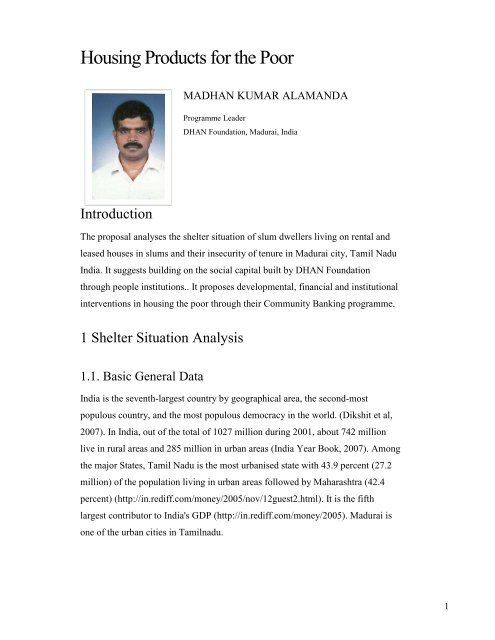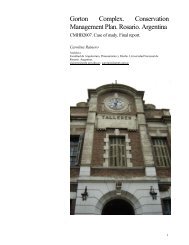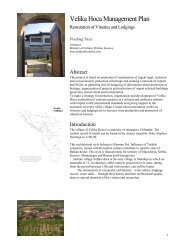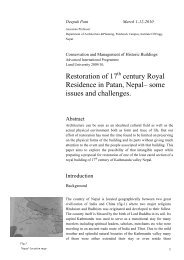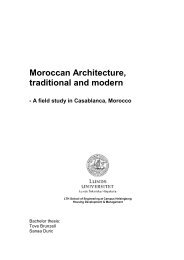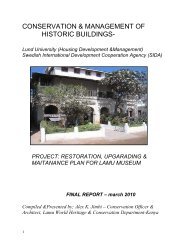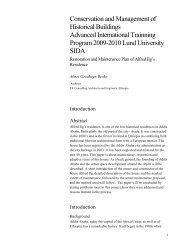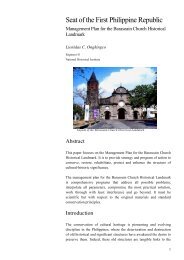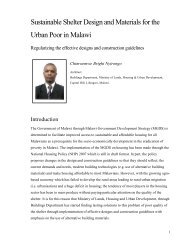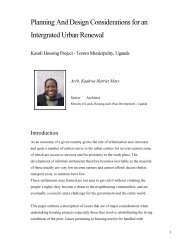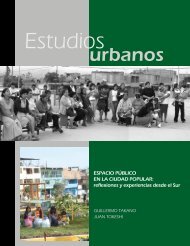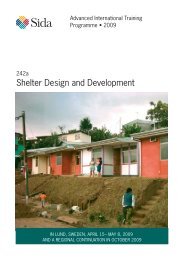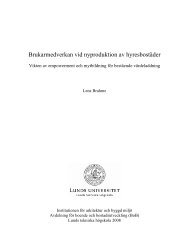Sample - Individual Work paper - HDM
Sample - Individual Work paper - HDM
Sample - Individual Work paper - HDM
You also want an ePaper? Increase the reach of your titles
YUMPU automatically turns print PDFs into web optimized ePapers that Google loves.
Housing Products for the PoorInsert your picturehere!MADHAN KUMAR ALAMANDAProgramme LeaderDHAN Foundation, Madurai, IndiaIntroductionThe proposal analyses the shelter situation of slum dwellers living on rental andleased houses in slums and their insecurity of tenure in Madurai city, Tamil NaduIndia. It suggests building on the social capital built by DHAN Foundationthrough people institutions.. It proposes developmental, financial and institutionalinterventions in housing the poor through their Community Banking programme.1 Shelter Situation Analysis1.1. Basic General DataIndia is the seventh-largest country by geographical area, the second-mostpopulous country, and the most populous democracy in the world. (Dikshit et al,2007). In India, out of the total of 1027 million during 2001, about 742 millionlive in rural areas and 285 million in urban areas (India Year Book, 2007). Amongthe major States, Tamil Nadu is the most urbanised state with 43.9 percent (27.2million) of the population living in urban areas followed by Maharashtra (42.4percent) (http://in.rediff.com/money/2005/nov/12guest2.html). It is the fifthlargest contributor to India's GDP (http://in.rediff.com/money/2005). Madurai isone of the urban cities in Tamilnadu.1
MADHAN KUMAR ALAMANDAGeography and AdministrationMadurai city has an area of 52 km2, within an urban area now extending over asmuch as 130 km2 (http://www.madurai.com/general.htm) and it is located at9°56′N 78°07′E9.93°N 78.12°E (http://www.madurai.com/general.htm). It has anaverage elevation of 101 meters above mean sea level. Temperatures duringsummer reach a maximum of 40 and a minimum of 26.3 °C, though temperaturesover 43 °C are not uncommon. Winter temperatures range between 29.6 and 18°C. The average annual rainfall is about 85 cm(http://www.fallingrain.com/world/IN/25/Madurai.html).Fig 1.Geographical location of MaduraiThe entire Madurai district comes under the direct control of the District collectorand the corporation limits within it is administered by Commissioner, MaduraiMunicipal Corporation. There are 72 wards and elected councillors of those wardsjoin Council of Madurai Corporation, select the Mayor of the city2
Housing for the poorDemography and Health..As per the 2001 census, the city corporation had a population of 928,869. Thepopulation of the Madurai urban agglomeration was 1,203,095(http://www.citypopulation.de/India-TamilNadu.html). In Madurai, malesconstitute 50.53% of the population and females 49.46%. (Census of India, 2001).Basic health indicators maintained by the Corporation, the City registered 20,429births and 5,327 deaths in 2009. The other indicators are presented in Table 1.Table 1: Basic Health Indicators of Madurai Corporation, 2009Sl. No. Vital statistics Madurai Tamilnadu India1 Birth Rate 18.0 15.8 23.12 Death Rate 5.0 7.2 7.43 Still Birth Rate 8.0 NA NA4 Infant Morality Rate 8.0 35 555 Maternal Morality Rate 0.5 NA NA6 Expectation of Life at Birtha. Male NA 65 62.6b. Female NA 67.4 64.2Source: The City Health Officer, Madurai Corporation, 2009EconomyAccording to Census 2001, the urban <strong>Work</strong>force Participation Rate (WPR) is34.18 percent which was 31.87 percent in1991 (including marginal workers)(Census of India, 2001). The positive growth in WPR in urban area can beattributed to the growth in the Service Sector of which the contribution of urbanpoor is predominant.1.2. Shelter Related Fact and FiguresAccess to ShelterMadurai city is facing acute shortage of housing stock, mainly attributed to thephenomenal growth of the city with influx of rural population, increase in tourismrelated activities and conversion of building use. There is a need to add 60,000houses in the next 10 years to meet the demand (CDP, Madurai Corporation,2006).3
MADHAN KUMAR ALAMANDATable 1: Basic Data on Madurai CorporationS.No. Particulars Quantity1 Population (2001 Census) 928,8692 Growth rate 16%3 Life Expectancy 664 <strong>Work</strong> Participation Rate 34.18%5 Average Household 4.326 Yearly increase in dwelling 15.8 %7 Floor area per person 11.8 sq.m8 Population Density 231 per ha9 Literacy Rate 77.6%10 No of notified slums 16811 No of objectionable slums 40Source: City Development Plan, Madurai CorporationOut of 257,850 families in Madurai Corporation, 198,051 families are living inhouses (including rental houses) and 59,799 (23.2%) families are without properhousing facilities. (Census of India 2001). They are living in temporary shelters,in public buildings, or thatched houses in public places (encroachment). (CDP,Madurai Corporation, 2006).According to the standards prescribed Tamilnadu Town and Country Planningwhich is responsible for norms and codes states, the minimum plot extent is 220sq. m for the residential purpose and 300 sq. m for the commercial purposes. Likewise minimum frontage to be left is 9 m which will allow optimum level ofsunlight and air helps in healthy housing. (Source: Tamil Nadu GovernmentGazette 2010)In Madurai Corporation, the floor area per person in Madurai Corporation is11.5 sq m. About 88% families (174,285) are living in single roomed or biroomedhouses in Madurai (SES report, Madurai Corporation, 2009). There arethree kinds of ownerships viz., Patta holders (title deed), Porambokku lands(government lands) and encroachments. Water bodies, burial grounds, channelsand Railway lands are some of the objectionable lands where Government objectanybody to reside there. But 54297 (23.2%) in Madurai (Madurai Corporation,2009) and 10859 (4.7%) families of India are living in such objectionable lands(Census of India, 2001). In the Indian context paternal transfer of ownership of4
Housing for the poorany asset (Mitakshara system) is common. Hindu Succession Amendment Act1990 (Tamil Nadu) made a remarkable development. This law stated that therights of the daughter are equal to that of the son, in any circumstances.In Madurai, all the rental houses are rented formally. House taxes are collectedseparately for the rental and own houses. Once in five years an assessee wasappointed to assess the house tax based on the prevailing rental rates. 68.5%families (135,665) are living in rental houses and 31.5% (62,386) families areliving in their own houses (Madurai Corporation, 2009). In Madurai Corporation62,386 families (24.2%) out of 257,850 families are affordable to have an ownhouse in Madurai Corporation..(SES report, 2008, Madurai Corporation, 2009In Indian context, aggregates (Coarse, medium and fine), Brick, Sand, Cement,Lime, Steel rod, Weathering tiles(4 varieties), Wood, PVC pipe fittings forelectrical fittings and water supply and drainage structures, Paints, Mosaic orPolished granite slabs and marble slabs for flooring, Jolly windows are commonlyused materials for a house construction. Alternative Building materials for lowcost housing are now utilised.Access to and cost of Basic Services/InfrastructureThe basic services dealt in the corporation are provision of water supply, stormwater drainage, sewerage, street lighting and health. Madurai Corporation meetsits water demand through Surface and Sub- Surface Sources namely Vaigai river.As a result, 50 percent of the households are not covered with the Corporationdrinking water. Madurai is provided with network of storm water drains up to alength of 170 kms, which is only 28 percent of the total road network of the City.The corporation generates approximately 450MT of solid waste per day, at therate of approximately 406 gms per capita, which is on par of cities of similar size(Source: City Development Plan, Madurai Corporation.)The ULB is divided into four Zones, for provision and maintenance of Streetlighting. The ULB is provided with 24,103 street lights at approximately 30 minterval, to light the City. Discussion indicated a high efficiency of operation withapproximately 97.5 percent of the Street lights is in working condition. There are456 doctors are practising and the doctor ratio with population is 1:2400 and thereare 340 Private Hospitals functioning in the city. Further 43 Nos. of Medical5
MADHAN KUMAR ALAMANDAOfficers and 48 paramedical staffs are working in Madurai Corporation. Forgeneral sanitation there are 40 Nos. of sanitary inspectors and 72 of conservancyinspectors and 60 Sanitary Supervisors with 2130 Numbers. of Sanitary <strong>Work</strong>ers.Access to and cost of EducationMadurai City has a literacy rate of 77.62 percent, which is marginally high incomparison to the district figure. The literacy rate has improved over the lastdecade, in lieu of the City’s growing significance in the region and presence ofGovernment and Private Educational Institutions. In order to regulate the feesstructure of the private schools and to reduce the burden of parents Tamil NaduState Government enacted a fees regulation act during the current academic year(2010 – 2011) which has made education accessible for all.1.3. Housing Policy:At the end of the 10th Five Year Plan, the housing shortage is estimated to be 24.7million. The National Housing Policy of 2007 laid emphasis on both quality andcost-effectiveness especially to vulnerable sections of society. All States to beencouraged to develop a “Habitat Infrastructure Action Plan” for all cities with apopulation of over one lakh. (National Urban Housing and Habitat Policy, 2007).Under Jawaharlal Nehru National Urban Renewal Mission , the whole corporationis envisaged to have all the basic facilities especially sewerage, storm waterdrainage, solid waste management drinking water supply, houses for urban poor.The programme benefited those who are in notified areas having land titles but athigh cost of debts as the subsidy was covering only 40% of the total costs.1.4. Actors in Shelter Delivery and their roles:The major actors involved in shelter delivery are the national / centralgovernment, state government, urban local bodies (ULB), private shelterdevelopers and citizens.. The Central government provides capital and interestsubsidy on housing loan and shares infrastructure costs for an affordable House.The State government based on the availability allocates land, draws policyguidelines for zoning the cities, regulates floor space index and shares6
Housing for the poorinfrastructure costs along with the urban local body. The role of private shelterdeveloper are offering bids based on the number of free houses (ownership/rental), viability Gap Funding , undertakes construction with the State government orULB and citizens residing claim their entitlements, contribute towardsconstruction of houses.Major slum improvement programs are being implemented in Madurai viz.,National Slum Development Program (NSDP), Swarna Jayanti Shehari RojgarYojna (SJSRY), Slum Improvement Schemes under TNUDP loan, andAccelerated Slum Improvement Scheme, Urban Self-Employment Program(USEP). National Slum Development Program (NSDP), Tamil Nadu SlumClearance Board (TNSCB) has taken-up construction of blocks for slum dwellersunder the environmental Improvement fund. Under this scheme a fireprooftenement of size 10x10 ft. will be constructed by TNSCB outside the limits ofCorporation, with off-site infrastructure facilities. Corporation is also involved invarious community development activities in Slums.1.5 Shelter DesignMaster Plan is a key development plan to provide land use allotment forresidential, commercial, industrial, public and semi-public, traffic andtransportation, parks, play fields and open spaces, etc., taking into considerationthe existing land uses. The review of the land use pattern of Madurai City, for2001, indicates that approximately 88 percent of land is being put to developeduse as against 72 percent in 1994. Presently, approximately 48 percent ofdeveloped area is put to residential use, 18 percent area under transportation and 9percent area under commercial Use. Area under commercial & education use hasincreased by more than 200 percent each, which is not adequately supported byallocation of area for circulation and transportation. (Source: City DevelopmentPlan, Madurai Corporation).The population density of Madurai City is very high, approximately 213Persons per ha in 2004 in relation to the density of 181 Persons per ha in 1991.The National and State governments have passed regulations on safety housing, toavoid the hazards which ever are possible to occur under Indian environment.. As7
MADHAN KUMAR ALAMANDAfar as slums are concerned, no rules, safety measures, minimum housing normsare followed.According to Town and Country Planning act (Tamil Nadu, 2010) minimumFloor Space Index (FSI = Floor area available for utility/Total land area) shouldbe 1.5 sq. m for the Category-I houses and 2.5 sq.m for category III houses. Itmight be adopted in the houses constructed in formal lands. The houses in theslums of Madurai are having FSI less than one (SES report, Madurai Corporation,2008). Moreover nearly 25 percent households of the slums are rearing cows andpoultry which occupy 10% floor space of their house. This makes the situationworse besides transmitting vector diseases.Social inclusion is ensured by the government / NGO’s through promotion ofself help groups for women members in particular to poor to organise themselvesand to ensure access to credit from mainstream institutions. The houses in slums(66%) are semi permanent (tiles and thatched houses) in nature (ILSP surveyreport, 2009) and are susceptible to natural hazards which in turn directly hit thewomen in slums. Slums are established over the water bodies are prone to flood,causes unsafe conditions to women. About 21.3 percent slum households aregoing for open defecation and urination. Men can go for open defecation at anytime which is not possible for the women. Slum women are helpless to disposetheir menstrual wastes in proper manner due to lack of daily waste collectionprocess. Alcoholism among men affects the home makers and plunge them inpoverty leads to moral insecurity and disorders.Sustainable city planning should aim at achieving social and environmentalequity while improving the lives of the people. At Madurai, the issues arecovering the deficiencies in services and providing the services in an environmentfriendly way. This is being facilitated by the Directorate of Town and CountryPlanning providing norms and codes.2 OrganisationDHAN Foundation (www.dhan.org) with its thematic intervention has reachedmore than 8.0 lakh (0.8 million) poor members across India. It has promotedpeople institutions through its thematic programmes namely KalanjiamFoundation, Vayalagam Foundation, Information technology, Rainfed Farming8
Housing for the poorand Panchayat Programme. DHAN Foundation with its experience in the urbancontext is the advisor in the Jawaharlal Nehru National Urban Renewal Missionfor 66 mission cities across India. and has become the promoter of technicaladvisory groups in all the cities to shape the destinies of cities in collaborationwith the respective Municipal Corporations.(http://www.jnnurm.nic.in/nurmudweb/tag/City_Commuque2.pdf)DHAN Foundation through its thematic programme namely KalanjiamFoundation has promoted 87 Federations comprising of 15202 groups with228030 members through its community banking programme. The Federations inthe programme has mobilized Rs.9929.37 lakhs ( $ 22.07 million ) as savingsfrom members and has loan outstanding to the tune of Rs.19241.33 lakhs ( $42.76 million ) addressing the various needs of the urban poor, of which, underhousing, the portfolio is Rs. 960.34 lakhs ($ 2.13 million ) and has effectiverepayment... It works with the members who are residing at objectionable areasfacing insecurity of tenure and oppressions from muscle powerIn Madurai, it has promoted seven federations comprising of 1200 groups with25000 members through its community banking programme in 110 slums.Federations are people entities promoted by 250 to 300 groups in the corporationarea.. Among the members, about 23 % have title deeds to their houses, 60 % livein rental and 17 % live on leasing. The demand is to provide housing products forthis clientele. The urban federations have leveraged resources from themainstream institutions like commercial banks, private banks, corporation etc topromote urban poor livelihoods and to arrest drains due to exploitative credit ratesresulting in enhancement of quality of life3. Shelter Problem:The shelter problem identified by the situation analysis is housing the urban poorwho are living on rental and leasing in slums. The data collected from theTamilnadu Slum clearance Board shows that 60328 households with thepopulation of 303231 reside in slums of Madurai as per census 2001 data. (TamilNadu Slum Clearance Board, Madurai). Demographic data available on Slumsindicates that slum population as a percentage share of Ward Population varies9
MADHAN KUMAR ALAMANDAfrom a maximum of 69 percent in Ward 31 to 3 percent in Ward 39 and Ward 36.About 71.5% increment is seen in slum families for the period of seven yearsfrom 2001 to 2007 while it is 1.8% increment in the housing stock for the periodof 9 years from 2001 (1,94, 552) to 2009 (198,051). (City Development Plan,Madurai Corporation). The performance indicators in the slums at MaduraiCorporation are as follows:Performance Indicators of Slums in MaduraiSl.IndicatorCurrentBenchmarkNo.Situation1 Slum population as % to Total Town Population 27.35% < 10.0 %2 Household size in Slums (Persons per HH) 5.03 -3 Distribution Network Reach (against Roadlength inslums) in Slums4 Slum Population per Public Stand Post/ HandPumps5 Slum Population per Seat of PublicConvenience/ ISPComplex80% > 100.0 %119 Persons 75 Persons301 Persons 60 Persons6 Road Length (Per Capita Road Length) 0.36 0.25 to 0.517 No of slums 168 (notified) 40(objectionable)Source: City Development Plan, Madurai CorporationIn Madurai Corporation boundaries, about 24% of the people don’t have houses.Of the total houses 68.5% houses have been let for rent and remaining 31.5%houses are being used by owners (Madurai Corporation, 2009). Out of 72 wards inthe corporation, most of the wards have notified and objectionable areas. Of thetotal slum households about 60% (36,197) are living in the rental /leased houses(SES report, Madurai Corporation, 2008). Shelter situation analysis revealshousing the poor who are residing in slums on rental and lease is the majorproblem.The people who are affected by the problem are slum dwellers. The poor liveon rental / lease in slum areas. They reside in notified areas and also objectionableareas facing eviction at any point of time by civil authorities and landlords. Thenature of dwelling is either in having in own sites, or on rental or on lease innotified and objectionable areas. The people who own the land title are also10
Housing for the poorlacking basic facilities like individual toilet due to density and also due to lack ofspace. A survey on Integrated Low Cost Sanitation Programme revealed that atotal of 18,878 families are not at all using toilet in their life. Building materialsutilised for construction of the houses in slums are at the sub-standard level whichwill lead a questionable situation on the stability of the houses. This is not apreferable situation on safety point of view. Even though Under ground DrainageSystem and storm water drainage system have been provided Under JawaharlalNehru Urban Renewal Mission (JnNURM) in Madurai, they are not properlyimplemented in slums due to lack of spaces in between houses and sufficient roadspaces. This will make the slum households to remain in the same unhygienicconditions.People who reside in notified areas are subject to enhancement of rent inalarming proportions by the land owners who reside outside the slum. Dwellershave to yield to them because of the proximity towards to their livelihood andservice facilities. Of the total slum households about 60% (36,197) are living inthe rental houses. (SES report, Madurai Corporation, 2008). The landlords are onlook out for people for lease as it entails lot of amount at a single stretch whichdeprives the people who have only capacity to pay rent. Even people who are onlease as they don’t have any registered deed for lease and they are subject tothreats by landlords when others offer more amount on lease. Hence, the slumdwellers are affected as their income is drained by the increase in rental andleasing costs and exorbitant interest rates charged by money lenders. The pressureon the city of these slums is felt by all the citizens and they are unable to takeconcrete action. The alarming rate of increase in rent by 100 % every year and theincrease in leasing amount by 80% puts the slum dwellers in a vulnerablesituation which necessitates them to borrow from money lenders at exorbitant rateof interest i.e. 4 to 5% per month.The shelter actors namely the national government, state government, urbanlocal body, real estate developers, financial institutions, non governmentalorganisation and beneficiaries can influence the problem. Under Jawaharlal NehruNational Urban Renewal Mission (JnNURM) efforts to create slum free missioncities have widened the gap between the rental poor benefiting only those whohave title deeds but it has landed them in debt as only part (40%) of the amount of11
MADHAN KUMAR ALAMANDAthe total cost was given for construction of houses. Government itself isconstructing housing board colonies on water bodies by filling up them withimproper filler materials. By this, the stability of the buildings constructed onthose water bodies is becoming questionable. Tamil Nadu Slum Clearance Boardwing of the state government has constructed houses on lease cum sale agreementfor the slum dwellers in the objectionable areas has made the dwellers to sell thehouses to third parties due to their over dues. Due to lack of coordination betweenthe state departments, adoption of housing policy amended by the SateGovernment has become the problem. There are no adequate institutions tosupport the housing finance at a lesser interest rate which deprives the slumdwellers their right for better quality of life and livelihood.Urban local body could not found alternate sites for shifting the urban poor dueto the limitation of corporation boundaries or remove the dwellers fromobjectionable areas due to the pressure of political system. Non governmentalorganisation are trying to organise the slum dwellers into self help groups foraddressing the consumption needs and has a fear of risking loans of higher sizebecause of the long tenure and lack of securitization. Few slum dwellers on theirown have joined together and have purchased sites considering the expansion inurban areas to build houses for posterity. Even though there is a provision forallotting sufficient residential area for poor during every zoning process, theofficials are not following it properly. This creates addition of new slums in sidethe corporation boundary.The problem of housing has appeared because of insecurity of tenure, increasein rental and leasing costs, migration of rural masses to urban in search oflivelihoods, increase in population and above all the threat of evictions by Civicauthorities in objectionable areas. Insecurity of tenure is due to the rental / leasingstatus of the dwellers, increase in rental and leasing cost is due to the inflation andthe exploitation of landlords in favour of better clients, migration is due to thesearch of livelihoods as the city is a heritage city and a tourist centre, the pressureof the state to make slum free city is also another reason for the dwellers who livein objectionable areas to resort for alternative propositions. People are not willingto incur any expenditure on basic amenities as their investment has no returns.Moreover, the increase in health expenditure due to lack of basic sanitation12
Housing for the poorfacilities and unhygienic conditions and for posterity has made them to thinkabout the alternative propositions for better quality of life.The problems exist due to inadequate space within the corporation boundarylimits, insufficient resources to explore alternative sites for relocation, inability tomobilise funds at cheaper rates of interest, state silence over the real facts of theslum dwellers. Corporation planning to rope in nearby municipalities to extend itsboundary limits could address few issues but management of basic services wouldbe costly venture where state has to invest considering the future. The alternatesites nearby corporation area are costly and if it is distant, it becomes inaccessiblefor their livelihoods. There is a need to balance the both. Considering the resourcebase and vulnerability of their livelihoods, banks are not willing to lend moneyand few successful attempts to mobilises resources through Self Help groups issufficient only for consumption purposes. Housing requires long term investmentsand perseverance of the lender to reap returns. State is silent on the issues as itrequires political will for the city development and orientation for consideration ofposterity.Summing up, the shelter problems identified are:a.. Housing the urban poor who are living in rental and leased houses in notifiedand objectionable areas because of alarming rental and leasing costs and basicinfrastructure facilities for their well being.b. Lack of enforcement of entitlements for poor by the state / urban local body andadherence of the housing policy to allocate houses for poor.c.. Inadequate institutions for housing finance and lack of long term investmentsor endo system or institutions for housing the rental urban poor.d. Limitation of corporation boundaries which does not give room or scope foralternate site exploration.Proposal for Change and ImprovementThe problem calls for innovative solutions for all the categories of slum dwellersnamely those who are on own, rental, lease in notified and objectionable areas.The solution should create an enabling environments, processes and institutionsthat improve the capacity of the poor to access viable social, technical andfinancial solutions and resources. This calls for reviewing the status of the13
MADHAN KUMAR ALAMANDApromoting organisation and its people institutions and member’s capability toaddress the housing needs of the urban poor residing in slums. This review ismade in the SWOT analysis to follow.SWOT AnalysisStrengthCommunity OrganisationSaving, Credit and Insurance practices.Technical Skills on construction and productpromotionLeverage resources from mainstream.SystemsProject management skillsWeaknessBad Housing repayment experience.Lack of Documentation on performanceof members.Lack of professional quality.Fluctuations in cash flow of slumDwellersHealth risks and area prone to Disasters.OpportunitiesBuilding on People SavingGroup Common fundLeverage of Resources from mainstreamInvestment of People institution fund to buildsolidarity and sustainabilityGovernment Schemes for entitlementsThreatsGovernment Subsidy for selected fewPoliticsLong Term RepaymentDisintegration of our groups due to GovtGroupsCost of land and building.The review of literature from the institutions and the course support show theinterventions possibilities namely on data collection, (lecture notes of JohnnyAstrand on Upgrading of Spontaneous settlements), factors in deciding viableinterest rate and interest subsidies (Enhancing Affordability / Accessibility ofEconomically Weaker Sections (EWS) / Low Income Groups (LIG) to Housingby Achal Gupta, <strong>HDM</strong> study) and the features of the institutions which weregiven credit support by Sida in Latin America ( Pankaj Joshi, A Sustainable14
Housing for the poorFinance Strategy for Low Cost Housing in Urban India —towards a Pro-PoorHousing Finance System <strong>HDM</strong> Student)Considering the strengths and opportunities of the organisation and banking onthe learning from the course and literature, the following proposal for change andimprovement is suggested for action under Developmental, Financial andInstitutional areas.Developmentala. Expansion of Corporation boundariesThrough its Technical Advisory Group promoted under Mission Cities atMadurai, influence will be made on the political system / state to expand thecorporation boundaries by integrating few municipalities nearby by thecorporation which will pave the way for provision of basic services to theexpanded area by the corporation. This will facilitate the rental households toexplore urban spaces with all the facilities without losing their connectivity totheir livelihoods. This will facilitate the increase in population is influencing theNational and State governments for accommodation of rental and leasedhouseholds residing in slum areas.b. Enforcement of EntitlementUnder the National Housing Policy, new site developments should have 20% ofthe area allocated for the urban poor. With the federations promoted by self helpgroups under the Community Banking Programme, pressure will be exercised bythe dwellers with the solidarity influence the corporation for ensuring theirentitlements like getting their compensation, allocation of land, interest subsidyetc.c. Shelter Development PlanThe inception document will screen the existing slums and identify the categoriesof ownership to identify the potential members for the shelter development,livelihood areas and their quality of life would be studied which will become thebase document. The assessment of functional needs and their life style will givethe shelter development plan for their well being.15
MADHAN KUMAR ALAMANDAd. Building Infrastructure for cluster housesConsidering the land availability as a major concern, the corporation couldfacilitate provision of basic infrastructure services namely on sewerage, stormwater drainage, water supply, solid waste management, sanitation, street lights etcwhich would subsidise the costs and be the morale booster for private investment.Livelihood CentresLivelihood centres based on the needs of urban economy namely on plumbing,electrical, home management, drivers, cell, television repair and maintenance etccan be envisaged for building the skills of the slum dwellers who have come onmigration for their sustainable livelihood.Financialf.. Study of socio economic profile of slum dwellersThe socio economic study on slum dwellers residing on rental / leased premises inslums of Madurai for assessing their capability and credential: The housing ofurban poor depends on the life cycle stages of family head, household income/cash flow, asset base and their ownership status namely rental, leasing, ownhouse, entitlements. Hence, there is an immense need to have a SWOT analysis ofhouseholds and actors involved to evolve relevant products / support servicesrequired.g. Savings and Sweat as EquityBuilding on the saving of the potential members as saving equity with betterinterest rates for graduating them as clientele under cluster housing would beanother criterion which will enable the people institution for mobilising theresources from the mainstream and the donor agencies, besides, sweat equity willbe also considered for the construction of houses to make it participative.h. Mobilisation of resourcesResources are required for construction / incremental housing for the slumdwellers. Leverage of resources can be done from banking system based on thegroups saving and repayment performance at market rates of interest. Grants fromfunding agencies can be mobilised to be used as revolving fund which will be lendat lesser rates of interest and revolved with the funding manager who will create a16
Housing for the poorcorpus for recycling the same for further housing construction for the urban poor.Efforts will be made to influence the government in the capacity of advisor to getthe interest subsidy for the loans given by the mainstream for construction ofhouses for the rental households residing in slums with the data base of theirexistence at slums for a period of more than 5 years.Development Design optionsBased on the functional needs assessment of the slum dwellers design optionsneed to be worked out for availing the options based on their capability and needs.Orientation on the advantages of harvesting rainwater, segregation of wastes andrecycling of waste water will be integrated as part of the design. Design optionswill cover the scope of giving infrastructure like road, electricity, houses based oneconomic criteria with foundation, without foundation and scope for furtherconstruction and management of space in the house.j. Setting up of Systems for OperationSince the relation with the dwellers would be of long run, there is a need forsetting up of management information system based on accounting and bookkeeping system maintained by the groups for their operation. Financialmanagement system will be in operation with the funding manager for ensuringthe revolving fund and also sharing of the output to Donor agencies. Integration ofown resources, grants, loan and interest subsidy will facilitate the slum dweller toconstruct the house.Institutionalk. Promotion of Housing Users Groups (HUG)Building on the organised entities under the community banking programme,potential slum dwellers will be organised into Housing User Group (HUG).DHAN Foundation is working with the slum dwellers who are residing in notifiedand objectionable areas under their community banking programme. The prioritywill be with the dwellers residing in objectionable areas and are vulnerable toexploitation by the muscle power. HUG will involve in framing byelaws for theiroperation, settlement planning, design, housing improvement, negotiation with thestakeholders on the services required and implementation.17
MADHAN KUMAR ALAMANDAl. Promotion of Guilds of Masons and ContractorsMost of the Slum dwellers are the construction workers instrumental in buildingthe houses for others. They would form in to guilds based on their occupation forundertaking the work at nominal rates for their own shelter development.m. Promotion of Housing Construction CompanyOutsourcing the equipment is a costly venture, hence basic equipments requiredfor construction will be purchased under the company from the common fundgenerated by each people entity will be contributed as equity for the constructioncompany which will be owned, controlled and managed by the people withprofessional guidance.n. Setting up of working committeesSetting up of working committees for purchase of land, exploration of resourcesfrom mainstream, construction of houses and integration with civic authorities toconstruct houses for the urban poor will be done under the aegis of PeopleInstitution.o. Exploring land pooling options for cluster housingLand pooling will be done based on the socio economic criteria based on the socioeconomic study. Land pooling will facilitate to carry out the unified servicing (DEWATS / sanitation and water management, open space, community space,connectivity and subdivision of separate land holding for planned urbandevelopments. This will enable to counter excessive land speculation andfacilitate clear land titles with out any encumbrances.18
Housing for the poorReferences• 2008 "Madurai General Information". http://www.madurai.com/general.htm.• 2008"Maps, Weather, and Airports for Madurai, India". Falling RainGenomics, Inc. http://www.fallingrain.com/world/IN/25/Madurai.html.• 2009, "Tamil Nādu - City Population - Cities, Towns & Provinces - Statistics& Map". Citypopulation.de. http://www.citypopulation.de/India-TamilNadu.html.• 2001, Primary Census Abstract – Census of India 2001.• 2005, Incidence & Rate of Total Cognizable Crimes (IPC) In States, UTs &Cities. http://ncrb.nic.in/crime 2005/cii-2005/Table 1.6 pdf.• 2007, "Urban Areas by Population Density", World Urban Areas (WorldAgglomerations). Demographia.• 2009, Management Information System, Madurai Corporation.• 2008, Socio Economic Survey Report under Basic Services for Urban Poor,JnNurm, Madurai Corporation.• 2006, City Development Plan under Basic Services for Urban Poor, JnNurm,Madurai Corporation.• 2009 Baseline survey, Integrated Low Cost Sanitation Programme(ILSP),Madurai Corporation.• 2010, Sanitation Ranking Study, A.C. Neilson_ORG MARG & Developmentand Research Services, CEPT University for Ministry of Urban Development,Government of India from December 2009 to March 2010.• 2007, Report of the 11th Five Year Plan (2007-2012) <strong>Work</strong>ing Group onUrban Housing with Focus on Slums, Ministry of Housing and Urban PovertyAlleviation (MHUPA), Government of India.• 2007, National Urban Housing and Habitat Policy, Ministry of Housing andUrban Poverty Alleviation, Government of India.• 2007, Compendium on United Nations Human Settlements Programme (UN-HABITAT), Information office, Chennai, India.pp15.• http://www.globalpropertyguide.com/Asia/India/price-gdp-per-cap19
MADHAN KUMAR ALAMANDA• 2007, Dikshit, K.R.; Joseph and E. Schwartzberg "India: The Land".• 2007, India Yearbook 2007. Publications Division, Ministry of Information &Broadcasting, Government of India. ISBN 81-230-1423-6.• 1996 Heitzman, J and R.L. Worden India: A Country Study. Library ofCongress (Area Handbook Series). ISBN 0-8444-0833-6.• 2007 "Tamil Nadu, The best place to do business". 12 November 2005.http://in.rediff.com/money/2005/nov/12guest2.htm.• 2010, S. Rengasamy, Introduction to Town Planning, pp:4.• Tamil Nadu Government Gazette, 16.06.2010.• 2004, Housing, health and safety Rating system,http://www.canterbury.gov.uk/main.cfm?objectid=1256• 2008, Vijayalakshmi Koorpad, Water and Sanitation in Slum Areas ofHyderabad, http:// www. hdm.lth.se /fileadmin/hdm/alumni/<strong>paper</strong>s/SDD_2008_242a/Vijayalakshmi_Koorpad_-_India.pdf20


